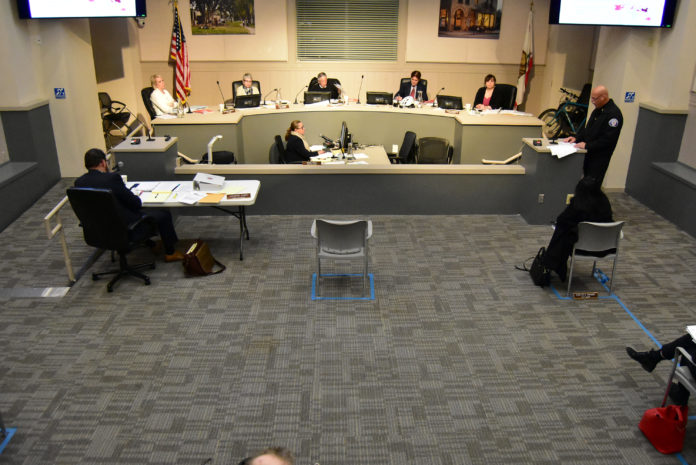
At what was likely South Pasadena’s last physical public meeting for the foreseeable future, the prospect of a far-reaching, county-wide “shelter in place” order overshadowed a clash over adoption of an emergency resolution suspending residential and commercial evictions in town due to the coronavirus-19 outbreak.
The resolution passed 4-1 after an outpouring of in-person and written support from individual renters, Holy Family and the Chamber of Commerce, all steamrolling opposition from influential businesswoman and WISPPA founder Ellen Daigle and 5th District Councilmember Diana Mahmud, who made arguments based on equity and practicality.
The specifics of the county health department order, which may come down as a “safer at home” directive, won’t be known until it is issued as early as today or Friday, said City Manager Stephanie DeWolfe. But if it is like the orders issued in Northern California and Orange County this week, a prohibition on evictions and utility shutoffs will be only one provision.
It will likely order residents to stay home and leave only for food, medicine and essential outings. It won’t mean you can’t leave your house. But restaurants would be restricted to delivery and take out service, and the only businesses that could remain open would be medical, pharmacies, grocery stores, banks, gas stations, laundry services and some child-care institutions.
In addition, the city itself would have to scale down to “essential services only,” meaning police, fire, water, sanitation, certain senior services like Dial-a-Ride and lunch, emergency response for fallen trees and such, and a handful of internal administrative services such as payroll.
“We want residents to be prepared for the next difficult phase of the response to the crisis,” DeWolfe said. The Council then heard a two-hour update from city department heads on adaptations they’ve made to respond to the crisis and documenting an overall 20 percent to 30 percent decrease in the demand for city services.
Five citizens spoke in favor of the eviction moratorium and the city clerk said she’d received at least 12 emails supporting that provision, including one with 66 signatures, while only two wrote in against it. Two councilmembers said they had received communications from bankers and property managers opining on the provision, including one who wanted protected renters to have to provide documentation of income lost due to the COVID-19 outbreak.
City Manager DeWolfe recommended postponing adoption of the moratorium, saying she did not feel the public had enough time to review the draft–which had been posted only 24-hours earlier– and because it was likely to be superseded by the County’s shelter-in-place order, raising the specter of a patchwork of municipal moratoria that would complicate enforcement.
“We want to have a compassionate resolution” especially in case the county order does not come through, said Councilmember Richard Schneider. He said it was important to “give the community the idea we are working to help prevent the eviction of renters. That would go a long way to satisfying public opinion.”
Councilmember Diana Mahmud, who owns two rental properties in Los Angeles, said while she sympathizes with renters, without some limitation on defaults or foreclosures against landlords, the resolution would not be fair. That’s because a substantial portion of the city’s rental units are composed of buildings with a small number of units owned by seniors who rely on rent payments to cover their mortgages.
She encouraged renters to be more forthcoming with landlords about their financial situations and to avail themselves of support programs such as the $1,000 the President has advocated and benefits from a new $150 million program the Governor just announced to help cities deal with homelessness.
Her other reason was more practical. The Los Angeles County Superior Court has been shut down through mid-April and when it resumes, judges will be swamped with a backlog of criminal cases that will take precedence over unlawful detainer actions, which themselves take months to process. “Realistically,” Mahmud said, “there is no way that a tenant is going to be forced to leave their home within this period.”
The meeting had a surreal feeling; the Council held it despite having cancelled all other city meetings and events and saying it would comply with government health orders to restrict gatherings of 10 or more people. It encouraged citizens to email their public comment. The chamber itself, which normally features something like 50 chairs for spectators and officials, had only five–each tightly surrounded by blue tape on the floor and carefully set no less than six feet apart in compliance with social distancing rules. Unaccountably, councilmembers sat at their dais, albeit as far apart as possible, but well within the prohibited distances.
Councilmember Richard Schneider alone participated as a disembodied voice from his home.















.png)






